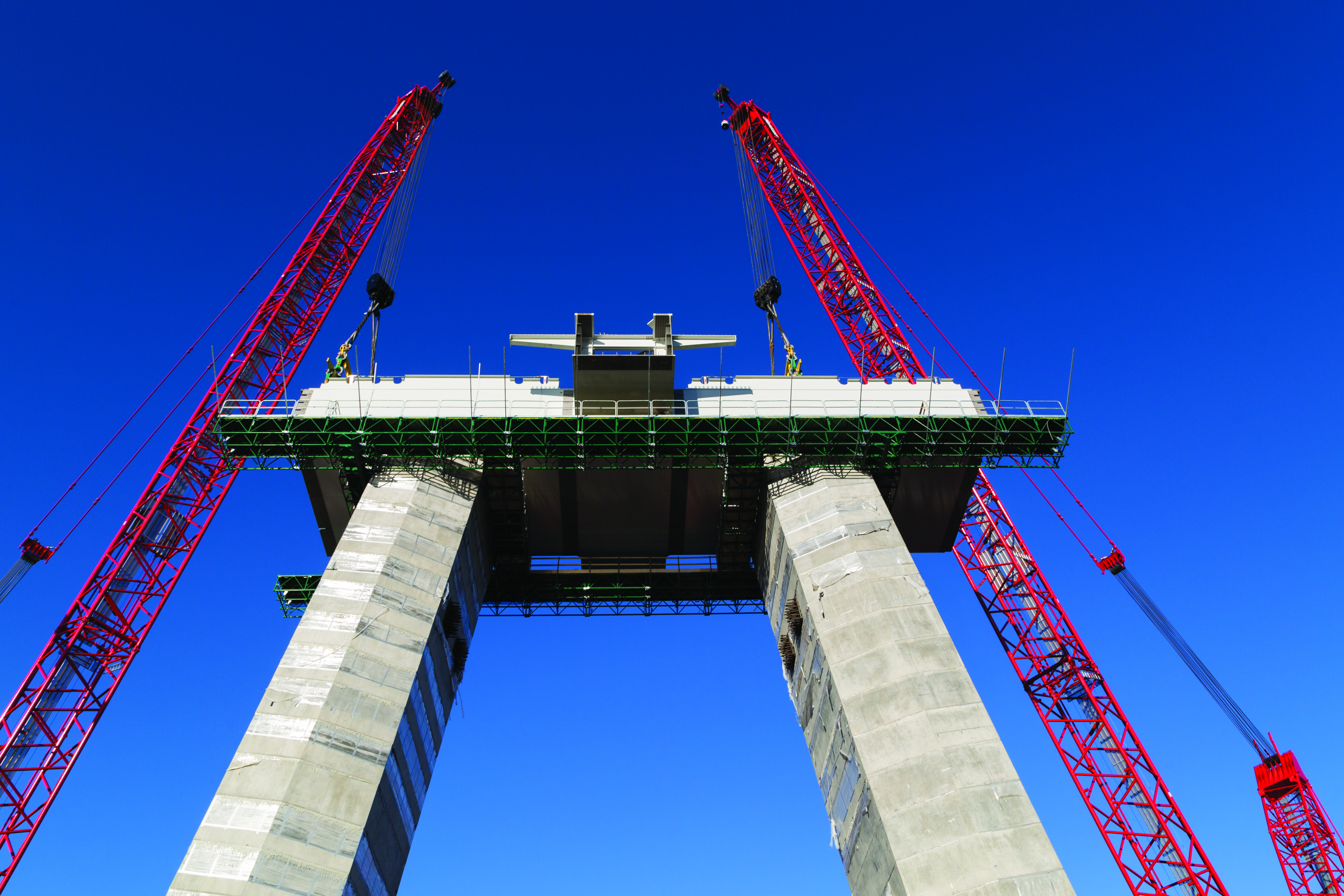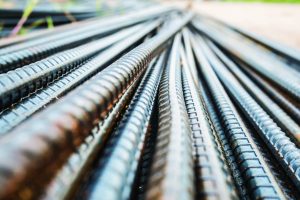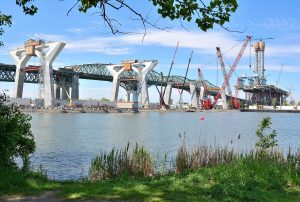
Steeling for a trade war: Canada’s dangerous, unavoidable dependence on foreign steel
By Saul Chernos
Construction Materials
(PHOTO: Signature on the Saint Lawrence)
An ongoing trade spat, which has seen the U.S. slap tariffs on a list of imports, has shone a spotlight on the Canadian construction sector’s dependence on foreign steel.
When U.S. President Donald Trump introduced the tariffs in March, he invoked an obscure clause in U.S. trade legislation that allows special measures for national security purposes. Canada and other key trading partners were initially spared though a temporary carve-out, but when the provision expired May 31 Prime Minister Justin Trudeau responded in kind and announced retaliatory tariffs on U.S. imports effective July 1.
Both countries set their tariffs at 25 per cent for most steel products and 10 per cent for aluminum. While the U.S. tariffs and the Canadian response injected some uncertainty into markets, both events also led to a spike in steel prices.
Looking to prevent large volumes of relatively cheap U.S.-bound foreign steel from being rerouted northwards, and thus undercutting domestic prices, Canadian primary producers lobbied for safeguard mechanisms to restrict seven specific categories, including steel plate, rebar, energy tubular product, hot rolled sheet, pre-painted steel, stainless steel wire, and wire rod.
However, with prices beginning to spike, a group of steel processors and end users formed the Canadian Coalition for Construction Steel to push back, warning that duties and quotas on imports from Canada’s other trading partners would severely disrupt construction activity, putting vital infrastructure and residential projects at risk.
Jesse Goldman, a lawyer with Borden Ladner Gervais who the CCCS engaged to help navigate the various trade complexities, says Canadian producers have the capacity to supply just half its domestic demand, adding that Canada has always needed and will continue to need steel imported from outside North America. In fact, he explained, the need is particularly acute because U.S. imports are now becoming more expensive and less available in Canada.
Goldman says the CCCS acknowledges the government’s need to retaliate against the U.S. but worries adding safeguards against other countries misses the mark.
“We understand the Canadian industry is in a difficult situation with the U.S. tariffs, but don’t amputate your leg in order to save your arm,” he says. “We have to be careful and analytical about how we support the domestic steel industry to ensure that an entire other part of the Canadian steel industry isn’t harmed along the way.”
Concerns about steel shortages and price hikes are already playing out. Goldman pointed to a developer withdrawing from a large project in Victoria, B.C. in August and an affordable housing project put on hold in Hamilton, Ont. around the same time. Both, he said, were attributed to rising steel prices and related construction costs.
The problem of supply and demand in Canada is complicated by geography. Some steel products are either not manufactured domestically or only in limited quantities. “We have a really big country with a pretty small population with steel mills almost entirely located in central Canada, so we have prohibitive transportation costs,” Goldman notes.
In a tariff-free environment, steel trucked from adjacent U.S. states is cheaper than steel hauled long distances from Canada’s industrial heartland. But a substantial price differential also applies to some overseas imports. To move steel from southern Ontario to the west coast by road or rail costs roughly $170 a tonne, whereas shipping that same tonne from Taiwan costs $29, Goldman said. Likewise, transportation to St. John’s, N.L. costs $250 from Montreal, compared with $50 from Istanbul.
“The coasts have a problem getting domestic steel – that’s always been the case. So they’ve been highly reliant on imports, largely from the U.S. but also from offshore,” Goldman says, noting that shipping mode, not distance, largely dictates transportation costs.
To illustrate Canadian construction’s reliance on imported steel, the CCCS singled out the Champlain Bridge replacement project currently winding up in Montreal.

(PHOTO: Getty Images)
While Montreal falls within Canada’s core manufacturing hub, Goldman emphasizes that Canadian mills, no matter where they’re located, don’t produce the specialty structural plate in the thicknesses and dimensions the bridge required, nor do they commercially produce stainless steel rebar at this time.
While bridges are major users of high-grade, specialty steel, so are dams, high-rises and industrial facilities. So, when steel prices spike or become unpredictable, fixed-price contracts become risky for contractors across the board. “They’re going to walk away from the business,” Goldman said, adding that delays occur when contractors need to track down affordable materials in order to make ends meet.
For their part, members of the Canadian Steel Producers Association would have preferred no tariffs in any direction, says President Joe Galimberti. “To suggest that Canadian steel is a threat to the national security of the United States is ludicrous on its face, and to impose tariffs on that basis is inappropriate,” he says. “We’d like to go back to a situation where there are no tariffs.”
With tariffs in place, however, the CSPA is promoting safeguards as legitimate mechanisms that comply with World Trade Organization and international trade rules.
“They’re not intended to cause commodity shortages or price shocks, they’re intended to safeguard Canadian industry against extraordinary times,” Galimberti says. “We’re hopeful the government is going to be prepared to move forward on a basis defined by the evidence available to them as regards [to] a surge of steel and the threat of significant harm to Canadian producers.”
Ed Whalen, the president and CEO of the Canadian Institute of Steel Construction, says its members fall along the entire supply chain, from producers, mills and service centres to engineers, architects and constructors, so he’s hearing multiple perspectives.
“Obviously the steel mills are worried for their own existence at the moment, so they want to make it as profitable as they can and get through this hump,” he says. “Downstream folks like service centres and fabricators just want consistency of supply and prices that won’t change everyday. And project owners want the most economical solution… that can stand the test of time.”
Estimating 70 to 75 per cent of the structural steel and 50 per cent of the rebar used in Canadian construction is foreign-sourced, Whalen said not all construction steel is equally affected by the tariffs. “No Canadian steel mills roll beams, so there aren’t any [retaliatory] Canadian tariffs on beams,” Whalen said, explaining that steel mills tend to be niche-driven and tariffs are generally not placed on products unavailable domestically.
That said, with U.S. mills adjusting prices as they navigate supply and demand, all types of steel, beams included, are experiencing market volatility. The U.S. tariffs have effectively allowed U.S. mills to increase prices of all products, so even if Canadian constructors aren’t slapped by Canadian import tariffs they’re impacted by higher prices due to U.S. tariffs.
The price confusion has muddied the terrain for everyone. “The U.S. tariffs have built a wall around themselves,” Whalen says. “They’ve encouraged more U.S. consumption of U.S. steel, because offshore steel is now a lot more higher-priced. So the mills in the U.S. are selling more of their stuff within the U.S., and it’s curbing the amount somewhat that used to be sent up here to Canada.”
Canadian Finance Minister Bill Morneau undertook a 15-day industry-wide consultation, which wrapped up at the end of August. While a decision was pending at press time, it’s entirely possible ongoing NAFTA negotiations will put a halt to the tariffs so far as Canada is concerned. That would be good news for the nearly 1.4 million people employed in construction in Canada, says Mary Van Buren, president of the Canadian Construction Association.
“We’re really happy the government invested $180 billion in infrastructure over the next 10 to 12 years, but this could be impacted if there’s a (supply) shortage or huge escalation in cost,” Van Buren says. “Project delays would ultimately deprive communities of the infrastructure projects they need to improve their quality of life.”
Should tariffs become the new norm, Van Buren says, the CCA hopes the government will offset the impact through tax relief measures such as accelerated depreciation of construction equipment, as well as mechanisms to protect contractors from price fluctuations, and a research and development fund allocated to the Canadian construction industry to improve productivity.
The CCA also hopes project owners will be more understanding and flexible in terms of fixed-price contracts.
“You’re talking about a huge industry that accounts for seven per cent of Canada’s GDP,” Van Buren says. “We’ve suggested the government find an alternative to safeguards because trade wars aren’t good for anyone and these safeguards will add additional hardship to a sector already facing major challenges.”
Christmas to come early in Montreal?

The Champlain Bridge construction site in Montreal, QC (PHOTO: Getty Images)
Even without tariffs on steel and aluminum, the Champlain Bridge project in Montreal has been a tough slog.
The new six-kilometre cable-stayed span replaces an aging and rapidly deteriorating adjacent structure, which has been operational since 1962 and linked Montreal with its south shore.
However, the replacement project has been besieged by multiple challenges, including load restrictions for the transportation of oversized pieces and up to 2,000 defects – ranging from cracked plates to missing welds.
In April, the federal government and Signature on the Saint Lawrence, the private-sector consortium building the bridge, resolved a long-simmering legal dispute. The settlement extended the planned opening from Dec. 1 to Dec. 21 and added $172 million to the overall $4.2 billion contract to cover construction delays, plus another $63 million related to the transportation of oversized parts.
But will SSL be able to meet the revised schedule? A report in June by the federal auditor general cast the Dec. 21 date as “very challenging.”
The auditor general concluded Infrastructure Canada didn’t plan the project in a cost-effective manner and didn’t adequately manage procurement risks to mitigate cost overruns and delays. The report issued multiple recommendations, including that the government question the cost-competitiveness of different procurement arrangements and revise its methods for evaluating technical criteria submitted in project bids.
“A work site the size of the new Champlain Bridge comes with its share of challenges,” says SSL spokesperson Véronique Richard-Charrier in a written reply to questions.
Richard-Charrier noted the bridge’s use of specialized steel, including 600 box girders and a steel superstructure. However, she declined to comment on how construction has been affected by tariffs, citing commercial confidentiality.
Saul Chernos is a freelance writer.
This article first appeared in the October 2018 issue of On-Site. You can check out the full issue here.




